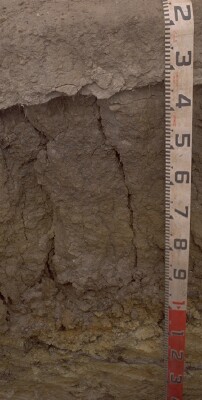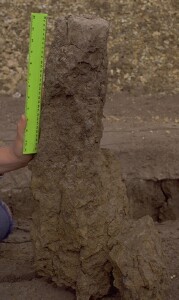SW81
Location: Yeo
Australian Soil Classification: Eutrophic, Mottled--Subnatric, Black SODOSOL
General Landscape Description: Low undulating hills.
Site Description: Gentle simple slope.
Geology: Basalt plain.
Soil Profile Morphology:
Surface Soil
| A1 | 0-10 cm | Dark brown (7.5YR3/2 moist); sandy loam; pH 5.3: |  SW81 Profile. Note: Surface (A1) horizon has been stripped from the soil profile. |
| A2e | 10-30 cm | Brown (10YR5/3 moist), conspicuously bleached (10YR7/2 dry); loamy sand; pH 5.5; sharp and smooth change to: | |
| Subsoil | |||
| B21 | 30-55 cm | Very dark gray (10YR3/1 moist); with yellowish brown (10YR5/6 moist) mottles common (~10%); heavy clay; strong consistence dry; coarse prismatic to columnar parting to coarse blocky structure; pH 6.4; abrupt change to: | |
| B22 | 55-100 cm | Light olive brown (2.5Y5/3 moist); few (<10%), brownish yellow (10YR6/6 moist) and very dark gray (10YR3/1 moist) mottles; heavy clay; very coarse prismatic to columnar, parting to coarse blocky structure; pH 6.7: | |
| C | 100+ cm | Weathered basalt. |

Very coarse prismatic ped in the B21 horizon.
Key Profile Features:
- Conspicuously bleached subsurface (A2) horizon.
- Very coarse prismatic columnar structure in subsoil.
- Strong texture contrast between surface (A) horizons and subsoil (B21) horizon.
Soil Profile Characteristics:
pH | Salinity Rating | |||
Surface (A1 horizon) | Strongly Acid | Medium | Non-Sodic | None |
Subsoil (B21 horizon) | Slightly Acid | Low | Sodic | Strong1 |
Deeper Subsoil (at 55 - 100 cm) | Slightly Acid | Low - Medium | Strongly Sodic | Strong1 |
| 1 Complete dispersion after remoulding. | ||||

| The surface soil is strongly acid. The subsoil is slightly acid. | Salinity rating is medium in the surface becoming low in the subsoil, increasing to moderate levels in the deeper subsoil. |
| The clay content increases markedly at the A/B boundary. |
Horizon | Sample Depth (cm) | pH (water) | pH (CaCl2) | EC 1:5 | NaCl % | Exchangeable Cations | |||
Ca | Mg | K | Na | ||||||
meq/100g | |||||||||
A1 | 0-10 | 5.3 | 4.7 | 0.24 | 4.4 | 2 | 1 | 0.48 | |
A2 | 10-30 | 5.5 | 4.6 | 0.05 | 0.46 | 0.56 | 0.07 | 0.14 | |
B21 | 30-55 | 6.4 | 5.1 | 0.15 | 3.6 | 11 | 0.21 | 3.3 | |
B22 | 55-100 | 6.7 | 5.7 | 0.39 | 0.06 | 4.2 | 11 | 0.2 | 5.7 |
Horizon | Sample Depth (cm) | Exchangeable Aluminium mg/kg | Exchangeable Acidity meq/100g | Organic Carbon % | Nitrogen % | Field Capacity pF2.5 | Wilting Point pF4.2 | Coarse Sand (0.2- 2.0 mm) | Fine Sand (0.02- 0.2 mm) | Silt (0.002- 0.02 mm) | Clay (<0.002 mm) |
A1 | 0-10 | <10 | 14 | 4.1 | 0.35 | 20.9 | 10.9 | 28 | 43 | 9 | 13 |
A2 | 10-30 | <10 | 2.8 | 9.4 | 1.7 | 33 | 51 | 6 | 3 | ||
B21 | 30-55 | 13 | 40.9 | 23.8 | 12 | 23 | 5 | 59 | |||
B22 | 55-100 | 9 | 44.2 | 24.1 | 11 | 23 | 5 | 58 |
Management Considerations:
Subsoil (B) Horizons
- The subsoil displays vertic features (i.e. slickensides) which indicates that significant shrinking and swelling occurs during wetting and drying cycles. This may have engineering implications and is likely to explain the variability in surface horizon depth across the trench.
- The dense and coarsely structured subsoil is strongly sodic and disperse strongly in water. This will result in restricted root growth down the soil profile.
Profile Described By: Richard McEwan (March 1999).


